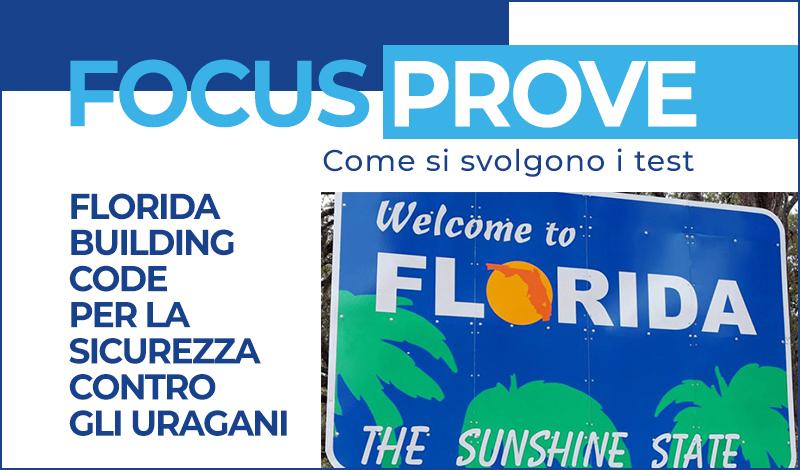Weather resistance of windows, doors, wall cladding and similar devices located in hurricane zones
(Pubbl. 14/09/2017)Tag:
safety
Our Security & Safety laboratory performs testing in accordance with American ASTM and AAMA standards, along with the various technical regulations of American federal states such as the FLORIDA BUILDING CODE and NEW YORK BUILDING CODE, etc.
These standards specify the test methods most frequently used and requested by Italian manufacturers doing business abroad (in particular in the United States, but also in the Far and Middle East).
ASTM International (formerly the American Society for Testing and Materials) is an American standards organisation. It is a major technical contributor to ISO standards and remains a leading figure for the specification of material and test methods in almost all industries, enjoying a quasi monopoly in the oil and petrochemical industry.
Founded in the USA in 1936, the AAMA (American Architectural Manufacturers Association) is one of the building sector’s most respected organisations representing manufacturers and professionals in the fenestration industry. Since 1962, the association has been mainly involved in drafting and, through certification programmes, demonstrating manufacturers’ compliance with performance requirements for fenestration assemblies such as windows and doors and their hardware, carrying out testing and on-site auditing.
 In the 1990s, the state of Florida was hit by a very violent series of hurricanes that caused enormous damage to households and several casualties. It was therefore decided to establish the Florida Building Code, a set of standards designed by the US state of Florida to ensure that buildings are resistant to the hurricanes and tornadoes that frequently occur in this area. The Code is administered by the Florida Building Commission, composed of 27 members including engineers, architects, contractors and specialists from various sectors.
In the 1990s, the state of Florida was hit by a very violent series of hurricanes that caused enormous damage to households and several casualties. It was therefore decided to establish the Florida Building Code, a set of standards designed by the US state of Florida to ensure that buildings are resistant to the hurricanes and tornadoes that frequently occur in this area. The Code is administered by the Florida Building Commission, composed of 27 members including engineers, architects, contractors and specialists from various sectors.This Code consists of 9 main volumes.
The volume “Test protocols for High-Velocity Hurricane Zones (HVHZ) - Fifth Edition (2014) dated March 2015” contains TAS (Testing Application Standards) that specify the test procedures required by the Florida Building Code.
In particular, as regards the mechanical strength required to guarantee the safety of a building’s occupants, the procedures set out are specified by these three standards:
- TAS 201-94 “Impact test procedures”;
- TAS 202-94 “Criteria for testing impact & non impact resistant building envelope components using uniform static air pressure”;
- TAS 203-94 “Criteria for testing products subject to cyclic wind pressure loading”.
These protocols cover wall cladding, glass block, exterior doors, garage doors, skylights, exterior windows, storm shutters and any other external component helping to maintain the integrity of the building envelope when hit by tornadoes or hurricanes.
TAS 201-94 “Impact test procedures” (Impact resistance)
The test is designed to determine whether a particular component used for the building envelope provides sufficient resistance to windborne debris during a hurricane. Using a compressed air cannon, the specimen is subjected to high-speed impacts with two types of impactor:
a) LARGE MISSIILE comprising a piece of timber of length 7 feet (2.1 m) having nominal dimensions of 2 inches by 4 inches (51 mm by 102 mm) and weighing 9 pounds (4.1 kg), propelled at a speed of up to 88 km/h;
b) SMALL MISSILE consisting of solid steel balls with a mass of 2 g and diameter 7.9 mm, propelled at a speed of 144 km/h.


TAS 202-94 “Criteria for testing impact & non impact resistant building envelope components using uniform static air pressure” (Wind Resistance)
The test is designed to determine whether a particular component used for the building envelope provides sufficient resistance to simulated static wind forces.
The specimen is sealed against one face of chamber inside of which a positive or negative pressure difference is created using equipment capable of setting the required load. The system also includes displacement transducers to measure specimen deflection.
The procedure of this test protocol is basically identical to American standard ASTM E330:
“Standard Test Method for Structural Performance of Exterior Windows, Doors, Skylights and Curtain Walls by Uniform Static Air Pressure Difference”.
Before and after testing, additional tests are possible to determine the air leakage rate in accordance with standard ASTM E283 or watertightness in accordance with standard ASTM E331.
TAS 203-94 “Criteria for testing products subject to cyclic wind pressure loading” (Cyclic wind resistance)

The test method involves subjecting the specimen to specific cyclic sequences of inward acting and outward acting pressure. At the same time, the air supply rate required to maintain the test pressure differential across the specimen is measured, whilst observing, measuring and recording the deflection, deformation and nature of any specimen distress or failure.
For more information contact:
Andrea Bruschi from Safety laboratory
Phone: 0541 322.388
E-mail a.bruschi@giordano.it










 Do you need more information about our services?
Do you need more information about our services?